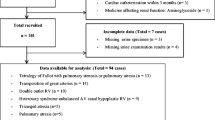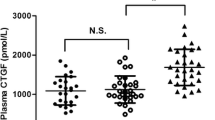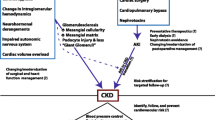Abstract
Cyanotic nephropathy (CN) is often accompanied by congenital cyanotic heart diseases (CCHD). The purpose of this study was to clarify the risk factors and the mechanisms of involved in the development and progression of CN. Thirty patients with CCHD were examined. We analyzed the risk factors for the development of CN on the basis of the clinical and laboratory findings. We also examined ten renal biopsy specimens obtained from patients with CN. Patients with CN showed significantly higher hematocrit levels than those without CN (P=0.025), although there was no difference between the two groups in terms of oxygen saturation. The renal plasma flow (RPF) in patients both with and without CN was low. However, the filtration fraction (FF) was significantly lower in patients with CN than in those without CN (P=0.001). The glomeruli of biopsy specimens with significant proteinuria (n=7) were larger than those of biopsy specimens without significant proteinuria, and there were more capillaries per glomerulus in the former than in the latter (n=3) and the control specimens (n=6) (glomerular size: P<0.01; number of glomerular capillaries: P<0.01). In conclusion, hyperviscosity by polycythemia may be responsible for the development of CN. This pathological condition may induce an angiogenic increase in the glomerular capillary beds, in turn leading to glomerulomegaly. In addition, the failure of a compensatory mechanism to respond to reduced RPF by hyperfiltration may be accompanied by the development and progression of CN.

Similar content being viewed by others
References
Spear GS (1964) The glomerulus in cyanotic congenital heart disease and primary pulmonary hypertension. A review. Nephron 1:238–248
Spear GS (1960) Glomerular alterations in cyanotic congenital heart disease. Bull Johns Hopkins Hosp 106:347–367
Tanaka J, Yasui H, Nakano E, Sese A, Matsui K, Takeda Y, Tokunaga K (1980) Predisposing factors of renal dysfunction following total correction of tetralogy of Fallot in the adult. J Thorac Cardiovasc Surg 80:135–140
Perloff JK, Latta H, Barsotti P (2000) Pathogenesis of the glomerular abnormality in cyanotic congenital heart disease. Am J Cardiol 86:1198–1204
Wilcox CS, Deng X, Doll AH, Snellen H, Welch WJ (1993) Nitric oxide mediates renal vasodilatation during erythropoietin-induced polycythemia. Kidney Int 44:430–435
Dittrich S, Kurschat K, Lange PE (2001) Abnormal rheology in cyanotic congenital heart disease–a factor in non-immune nephropathy. Scand J Urol Nephrol 35:411–415
Dittrich S, Haas NA, Buhrer C, Muller C, Dahnert I, Lange PE (1998) Renal impairment in patients with long standing cyanotic congenital heart disease. Acta Paediatr 87:949–954
Agras PI, Derbent M, Ozcay F, Baskin E, Turkoglu S, Aldemir D, Tokel K, Saatci U (2005) Effect of congenital heart disease on renal function in childhood. Nephron Physiol 99:10–15
Hagley MT, Murphy DP, Mullins D, Zarconi J (1992) Decline in creatinine clearance in a patient with glomerulomegaly associated with a congenital cyanotic heart disease. Am J Kidney Dis 20:177–179
Weibel ER (1979) Stereological methods: practical methods for biological morphometry, vol. 1. Academic Press, London, pp 40–160
Krull F, Ehrich JH, Wurster U, Toel U, Rothganger S, Luhmer I (1991) Renal involvement in patients with congenital cyanotic heart disease. Acta Paediatr Scand 80:1214–1219
Burke JR, Glasgow EF, McCredie DA, Powell HR (1977) Nephropathy in cyanotic congenital heart disease. Clin Nephrol 7:38–42
Hida K, Wada J, Yamasaki H, Nagake Y, Zhang H, Sugiyama H, Shikata K, Makino H (2002) Cyanotic congenital heart disease associated with glomerulomegaly and focal segmental glomerulosclerosis: remission of nephrotic syndrome with angiotensin converting enzyme inhibitor. Nephrol Dial Transplant 17:144–147
Fogo A, Hawkins EP, Berry PL, Glick AD, Myra LC, MacDonell RC, Ichikawa I (1990) Glomerular hypertrophy in minimal change disease predicts subsequent progression to focal glomerular sclerosis. Kidney Int 38:115–123
Fries JW, Sandstrom DJ, Meyer TW, Rennke HG (1989) Glomerular hypertrophy and epithelial cell injury modulate progressive glomerulosclerosis in the rat. Lab Invest 60:205–218
Nagata M, Kriz W (1992) Glomerular damage after uninephrectomy in young rats. II. Mechanical stress on podocytes as a pathway to sclerosis. Kidney Int 42:148–160
Eckardt KU, Hartmann W, Vetter U, Pohlandt F, Burghardt R, Kurtz A (1990) Serum immunoreactive erythropoietin of children in health and disease. Eur J Pediatr 149:459–464
Acknowledgment
This study was partially supported by a Health and Labor Sciences Research Grant (H16-Kodomo-015 to Dr. Iijima) and a Grant for Child Health and Development (16C-2 to Dr. Iijima).
Author information
Authors and Affiliations
Corresponding author
Rights and permissions
About this article
Cite this article
Inatomi, J., Matsuoka, K., Fujimaru, R. et al. Mechanisms of development and progression of cyanotic nephropathy. Pediatr Nephrol 21, 1440–1445 (2006). https://doi.org/10.1007/s00467-006-0220-5
Received:
Revised:
Accepted:
Published:
Issue Date:
DOI: https://doi.org/10.1007/s00467-006-0220-5




